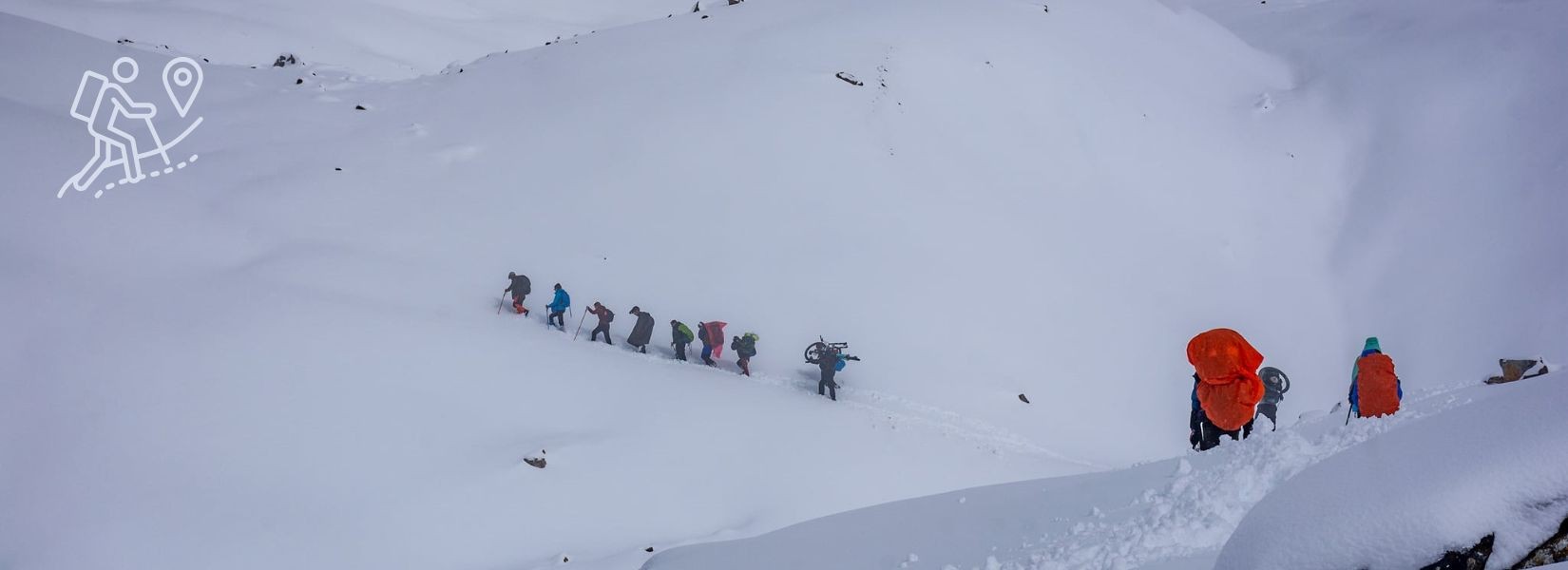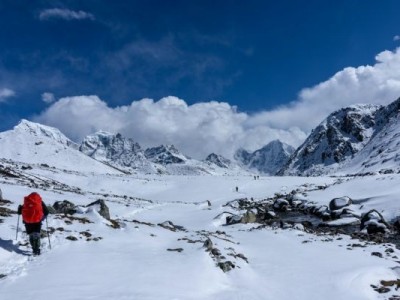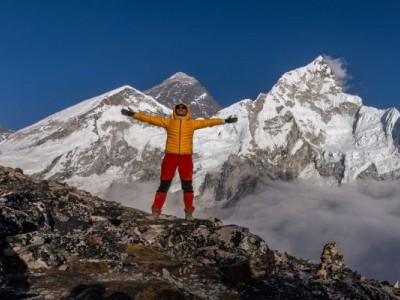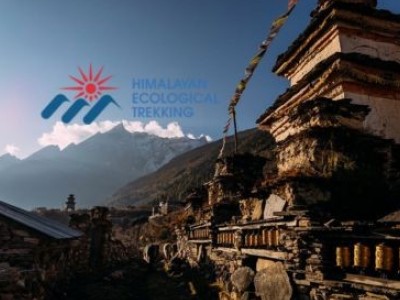How Difficult is the Annapurna Circuit Trek?
The Annapurna Circuit Trek is classified as a moderately difficult trek. It's hard at certain points, particularly at higher elevations, but it's not too hard for trekkers who prepare properly. Unlike technical climbing expeditions, this trek doesn't require specialised mountaineering skills, making it accessible to determined hikers with reasonable fitness levels.
Several key factors contribute to the overall Annapurna Circuit trek difficulty:
Annapurna Circuit Trek Day to Day Elevation Profile
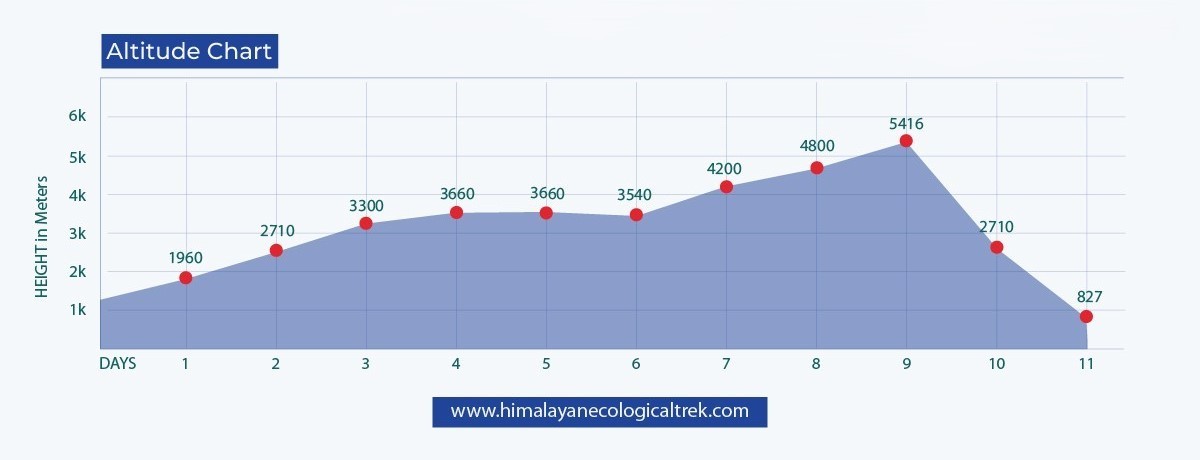
The most significant challenge is the high altitude that the route covers, which takes you as high as 5416m at Thorong La Pass. At this elevation, oxygen levels drop to about 50% of what's available at sea level, making breathing more laboured and physical exertion more demanding. The risk of Acute Mountain Sickness (AMS) becomes significant above 3,000 meters, requiring careful acclimatisation.
Distance & Duration
The complete circuit spans between 160-230km, depending on where you start and finish. Most trekkers complete the journey in 12-21 days. This extended period on the trail requires sustained physical effort and mental resilience. Each day typically involves 5-7 hours of walking, which can be taxing when repeated day after day.
For a clearer understanding of the route, refer to our Annapurna Circuit Trek Map, which highlights major stops, elevation gains, and alternate routes.
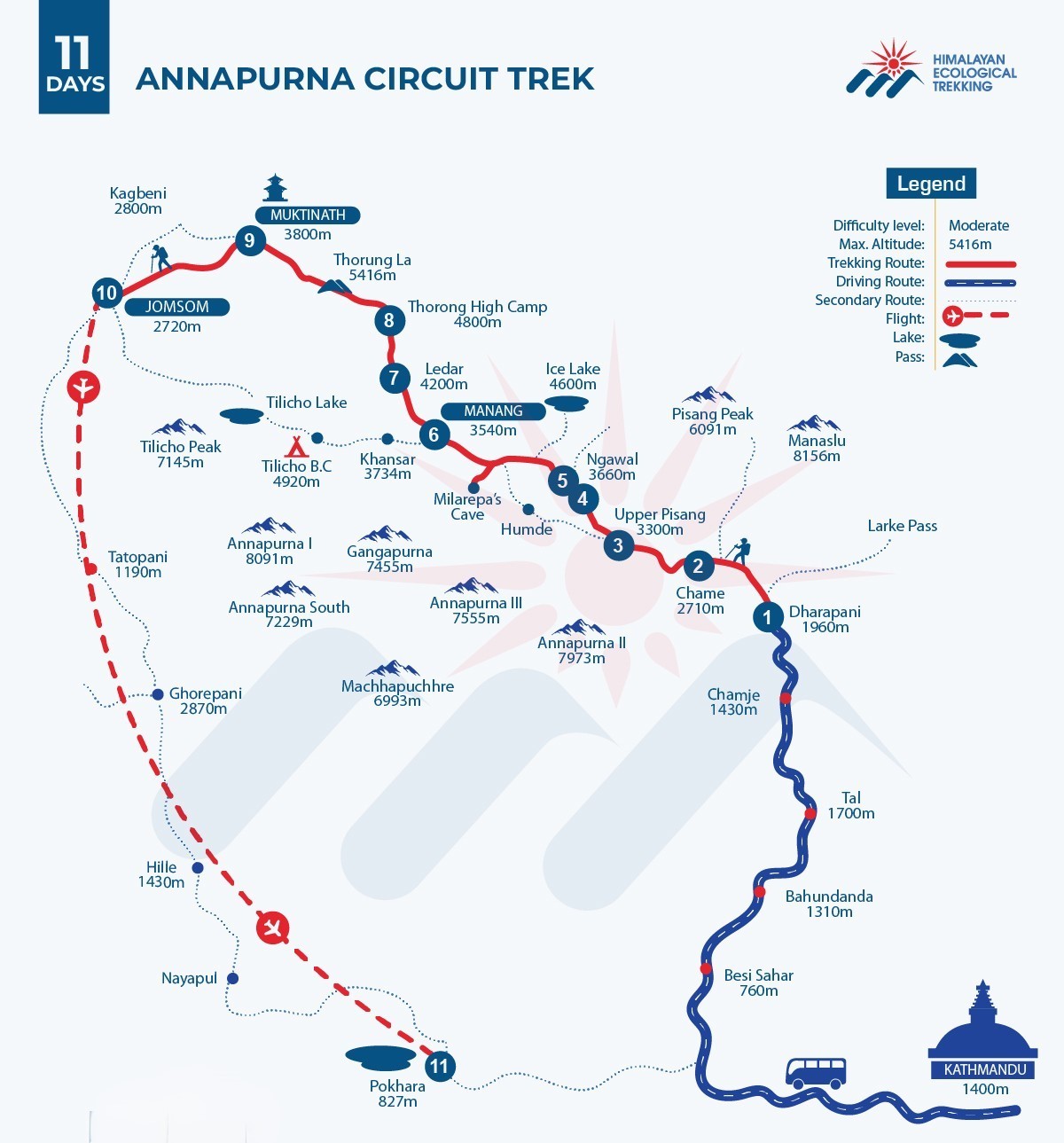
Terrain Variation
The trek features remarkable diversity in terrain:
- Initial days include gentle ascents through villages and forests, with no longer steep climbs for the first few days
- The middle sections follow river valleys with moderate inclines
- The approach to and crossing of Thorong La Pass involves steep, rocky terrain
- Post-pass sections through the Mustang region feature desert-like landscapes with strong winds
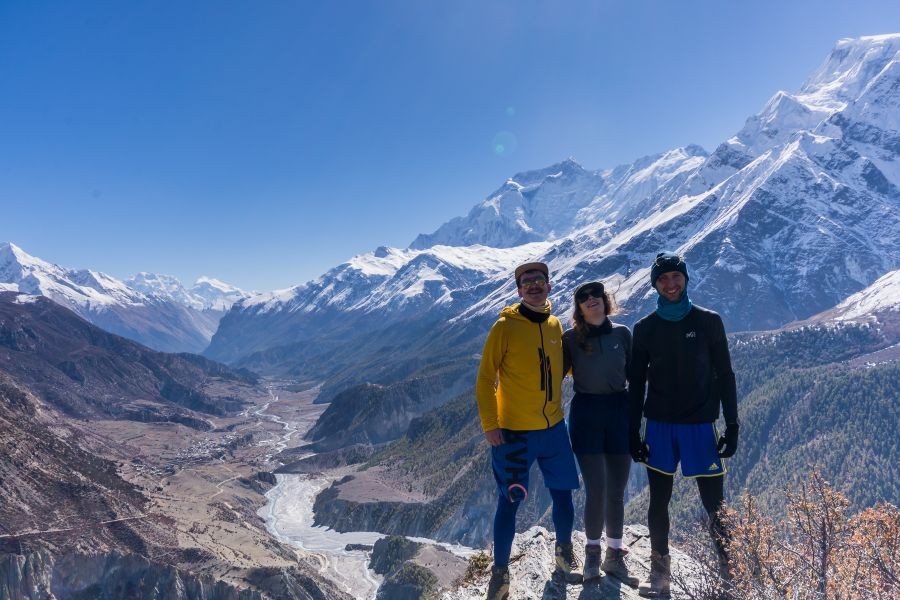
Weather & Seasonal Conditions
The weather can significantly impact the Annapurna Circuit trek difficulty level. Temperature variations between day and night can be extreme, especially at higher elevations. Seasonal factors include snow and ice in winter months and potential landslides during the monsoon season.
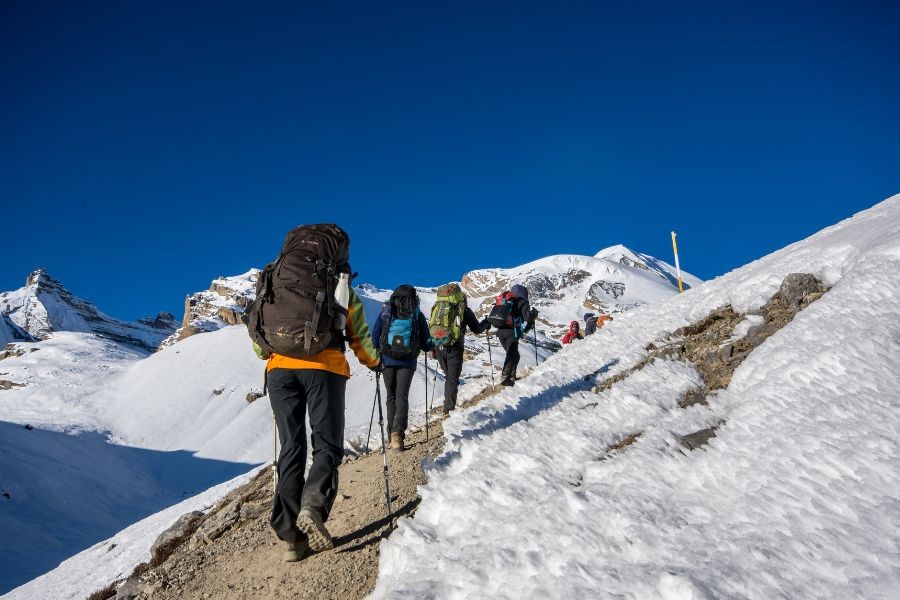
Breaking Down the Difficulty Level
A. Physical Fitness Requirements
The Circuit is very tough at times, particularly during the Thorong La Pass crossing, but with proper preparation, it's within reach for most reasonably fit people. You don't need to be an elite athlete, but you should be comfortable with:
- Walking 5-7 hours daily for consecutive days
- Carrying a daypack weighing 4-8kg
- Managing uneven terrain, including steps, rocks, and occasional steep sections
- Dealing with changing weather conditions
Your physical stamina will be tested most during the higher altitude portions, especially from Manang (3,519m) to Thorong La Pass (5,416m) and the subsequent descent to Muktinath (3,760m). This challenging day requires starting before dawn and can take 8-10 hours of hiking.
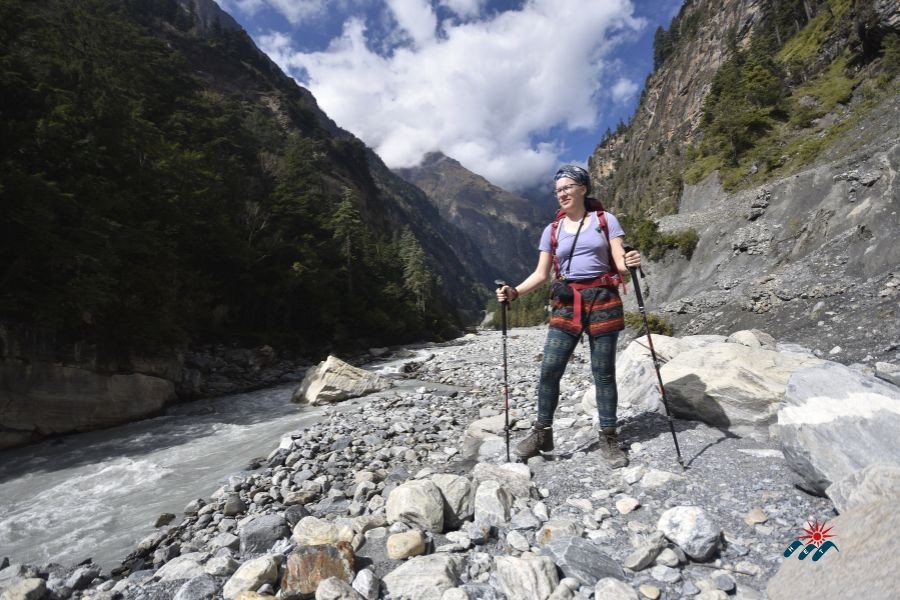
B. Altitude Challenges
The high altitude presents perhaps the most unpredictable aspect of the Annapurna Circuit trek difficulty. As you ascend, particularly above 3,000 meters, your body needs time to adjust to decreasing oxygen levels. Without proper acclimatisation, you risk developing Acute Mountain Sickness (AMS), which can manifest as:
- Persistent headaches
- Dizziness and nausea
- Loss of appetite
- Difficulty sleeping
- Shortness of breath
- Fatigue
A well-designed itinerary includes at least 1-2 acclimatisation days, particularly in Manang (3,519m), before attempting the higher sections. These rest days are crucial for safety, allowing your body to produce more red blood cells and adapt to the reduced oxygen environment. During acclimatisation days, many hikers adhere to the "climb high, sleep low" philosophy, ascending to higher elevations during the day and then descending to lower elevations during the night.
C. Trail Terrain & Daily Hiking Hours
The trail conditions vary significantly throughout the journey:
Lower Sections (800-2,000m)
- Well-maintained paths through villages and terraced fields
- Primarily gradual ascents with some stone steps
- Forest trails with moderate inclines
- Walking time: 5-6 hours daily
- Relatively comfortable trekking conditions
Middle Sections (2,000-3,500m)
- Rocky paths following river valleys
- Moderate ascents with occasional steep sections
- More exposed trails with some narrow passages
- Walking time: 5-7 hours daily
- Increasing effects of altitude become noticeable
Higher Sections (3,500-5,416m)
- Rugged, rocky terrain with loose scree in places
- Steeper ascents/descents, particularly around Thorong La Pass
- Possible snow and ice, depending on the season
- Walking time: 7-10 hours on pass day
- Significant altitude effects make progress slower
The most challenging sections include:
- The ascent to High Camp (4,850m) from Thorong Phedi (4,450m)
- The pre-dawn ascent from High Camp to Thorong La Pass (5,416m)
- The long 1,600m descent from the pass to Muktinath (3,760m)
These parts are demanding but become manageable with proper pacing, adequate rest, and appropriate clothing and equipment.
D. Weather & Seasonal Difficulty
The difficulty of the Annapurna Circuit trek varies significantly by season:
October-November (Autumn)
- Clearest skies and most stable weather
- Daytime temperatures: Pleasant (10-20°C at lower elevations, 5-15°C at middle elevations, -5-10°C at high points)
- Nighttime temperatures: Moderate to cold (5-15°C at lower elevations, 0-5°C at middle elevations, -10-0°C at high elevations)
- Lowest precipitation chances
- Busiest season with more crowded teahouses
March-April (Spring)
- Generally clear mornings with occasional afternoon clouds
- Slightly warmer than autumn
- Beautiful rhododendron blooms in the lower sections
- Some haze is possible, especially in late April
- The second most popular season
December-February (Winter)
- Very cold conditions, especially at higher elevations
- Daytime temperatures: Cold (5-15°C at lower elevations, 0-10°C at middle elevations, -15-0°C at high points)
- Nighttime temperatures: Very cold (0-10°C at lower elevations, -5-0°C at middle elevations, -20-(-10)°C at high points)
- Thorong La Pass may be snow-covered or even closed after heavy snowfall
- Fewer trekkers and some teahouses closed in the higher sections
- Requires more specialised cold-weather gear
May-September (Monsoon/Summer)
- Hot and humid at lower elevations
- Regular rainfall, especially in the lower sections
- Potential for landslides and trail damage
- Limited mountain views due to clouds
- Leeches are present in forest sections
- Least recommended season, though the upper Mustang section remains relatively dry
For most trekkers, autumn (October-November) offers the best time for the ACT Trek with the best balance of clear weather, stable conditions, and moderate temperatures. This period presents the lowest difficulty level in terms of environmental factors.
Comparing Annapurna Circuit Trek Difficulty vs Other Treks
Understanding how difficult the Annapurna Circuit trek is compared to other popular Himalayan adventures helps set appropriate expectations:
- Maximum altitude: Similar (EBC: 5,364m vs. Annapurna: 5,416m)
- Duration: Similar (EBC: 12-16 days vs. Annapurna: 12-21 days)
- Terrain: Annapurna offers more variety with both ascents and descents
- Cultural exposure: Annapurna provides more diverse cultural experiences across multiple ethnic regions
- Difficulty: Comparable overall, though Annapurna's pass crossing presents a unique challenge
- Maximum altitude: ABC is significantly lower (4,130m vs. 5,416m)
- Duration: ABC is shorter (7-12 days vs. 12-21 days)
- Terrain: ABC features more consistently steep sections
- Altitude concerns: Less severe for ABC due to lower maximum elevation
- Difficulty: The Annapurna Circuit is more challenging overall due to higher altitude and longer duration
Annapurna Circuit Trek (ACT) vs. Langtang Valley Trek
- Maximum altitude: Langtang is lower (4,984m vs. 5,416m)
- Duration: Langtang is shorter (7-10 days vs. 12-21 days)
- Terrain: Langtang has steeper initial climbs but shorter overall distance
- Accessibility: Langtang starts closer to Kathmandu
- Difficulty: The Annapurna Circuit is more challenging due to the high pass crossing and longer duration
For beginners wondering about the Annapurna Circuit trek difficulty level, it's worth noting that while more demanding than Langtang or ABC, its gradual ascent profile during the first week makes it accessible with proper preparation. The traditional route allows for excellent acclimatisation, making it feasible for first-time Himalayan trekkers who have good physical fitness and determination.
How to Get Ready for Trekking the Annapurna Circuit
Proper preparation dramatically impacts how difficult the Annapurna Circuit trek feels. Focus on these key areas:
Physical Training (3-6 months before departure)
Your training regimen should build gradually and include:
Cardiovascular Endurance
- Regular hiking (ideally 2-3 times weekly, building to 5-6 hours)
- Stair climbing with a weighted backpack
- Uphill walking or treadmill with an incline
- Cycling, swimming, or running for general fitness
Strength Training
- Lower body exercises: squats, lunges, step-ups
- Core strengthening: planks, bridges, rotational exercises
- Upper body work for backpack carrying: shoulder presses, rows
The most effective training is hiking on terrain similar to what you'll encounter in Nepal, ideally with a loaded backpack and varying elevation gains. If mountain hiking isn't available near you, use stairs, stadium steps, or stair machines to simulate climbing.
Mental Preparation
The psychological aspect of trekking is often underestimated. Prepare yourself for:
- Long days of continuous walking
- Basic accommodations with shared bathrooms
- Cold temperatures, especially at night
- Potential discomfort from altitude effects
- Simple meals with limited variety
- Periods of physical discomfort and tiredness
Developing mental resilience through consistent training helps significantly. Practice mindfulness and positive self-talk during your training hikes. Remember that thousands of trekkers of various ages and fitness levels complete this trek annually - persistence and determination often matter more than pure physical strength.
Essential Packing
Your equipment significantly impacts your comfort and safety. Key items include:
Clothing
- Moisture-wicking base layers
- Warm mid-layers (fleece/wool)
- Insulated jacket (down preferred)
- Waterproof/windproof outer layer
- Hiking pants (convertible recommended)
- Warm hat, gloves, and buff/neck gaiter
- Multiple pairs of hiking socks
Footwear
- Well-broken-in hiking boots with ankle support
- Camp/teahouse shoes for evenings
Sleeping
- Warm sleeping bag (comfort rating of at least -10°C)
- Sleeping bag liner for extra warmth
Trekking Equipment
- Trekking poles (highly recommended for descents)
- Headlamp with extra batteries
- Backpack rain cover
- Sunglasses (category 4 for high altitude)
- Water purification method
Health & Safety
- Altitude sickness medication in a first aid kit
- Sunscreen (SPF 50+)
- Lip balm with sun protection
- Hand sanitiser and toilet paper
- Diamox (consult doctor before use)
Pack as lightly as possible while ensuring you have essential items. Many trekkers aim for a main bag under 12kg (to be carried by a porter) and a daypack under 5kg (carried by you). Most items can be purchased or rented in Kathmandu if needed.
Why Choose Our Annapurna Circuit Trek Package?
Taking on the Annapurna Circuit trek difficulty becomes significantly more manageable with professional support. Our comprehensive package offers:
Expert Guides
Our experienced guides have:
- Completed the Annapurna Circuit numerous times
- Wilderness first aid certification
- Extensive training in altitude sickness recognition and management
- Deep knowledge of local culture, history, and geography
- English language fluency
Our guides carefully monitor each member's health, adjust pace appropriately, and make critical decisions about acclimatisation and safety. They know the best teahouses, local specialities to try, and hidden viewpoints not found in guidebooks.
Well-Planned Itinerary
Our carefully designed schedule includes:
- Gradual ascent profile (no more than 400-500m elevation gain per day above 3,000m)
- Strategic acclimatisation days before attempting higher elevations
- Flexibility for weather conditions or health issues
- Thorong La Pass is best done in the early morning.
- Balanced daily distances to avoid exhaustion
Sample Acclimatisation Schedule:
- Day 6: Rest day in Chame (2,670m) - Optional short hike to viewpoint
- Day 9: Acclimatisation walk to Ice Lake and rest day in Manang (3,519m)
- Day 11: Short walking day from Lower Pisang to Ngawal - Extra acclimatisation before higher elevations
This scientifically based approach maximises safety and comfort while minimising altitude sickness risk.
Comfortable Accommodation & Meals
We select the best available teahouses and lodges along the route, ensuring you have:
- Clean, comfortable sleeping arrangements
- Nutritious meals from varied menus
- Hot drinks and purified water
- Charging facilities were available
- Attached bathrooms were possible (in the lower sections)
Our relationships with teahouse owners ensure preferential treatment even in peak season when accommodations can be crowded.
Safety Measures
Your well-being is our priority with:
- Daily health examinations, which include measurements from a pulse oximeter
- Satellite phone for emergencies
- Comprehensive medical kit including emergency oxygen
- Detailed evacuation protocols if needed
- Regular weather updates and route adjustments
All-Inclusive Package
Enjoy peace of mind with all essentials covered:
- All necessary permits (ACAP, TIMS)
- Transportation to/from trailheads
- Three meals daily while trekking
- Accommodation throughout
- Experienced porters (1 porter for every 2 trekkers)
- All taxes and service charges
Frequently Asked Questions (FAQS)
Can beginners do the Annapurna Circuit Trek?
Yes, the Annapurna Circuit trek for beginners is possible if you prepare properly. While it's not ideal as your very first trek ever, people with some hiking experience and decent fitness can do it successfully. Going with a guided tour that sets a good pace makes it more accessible for newcomers who are determined.
What aspect of the journey is the most challenging?
Crossing Thorong La Pass (5,416m/17,769ft) is the most challenging part because of the high altitude, potential for cold weather, and steep climbing and descending. Starting very early in the morning (usually around 4 AM) in cold temperatures makes it even more difficult.
How dangerous is altitude sickness?
Altitude sickness can be serious, but it can be managed with proper care. Every day, our guides assess hikers for symptoms and modify the speed as necessary. Following the "climb high, sleep low" principle and taking rest days at certain elevations greatly reduces risks. If someone gets severe altitude sickness, the only solution is to go down to a lower elevation, which our team will arrange immediately if necessary.
How long does it take to complete the Annapurna Circuit?
The traditional route takes 16-21 days, though there are shorter options (12-14 days) that use vehicle transportation for some sections. We recommend taking enough time for your body to adjust to the altitude and to enjoy the journey rather than rushing.
Which season is ideal for trekking the Annapurna Circuit?
October-November has the most reliable weather with clear skies and comfortable temperatures. March-April is also excellent with the bonus of spring flowers, though you might get some afternoon clouds that limit mountain views.
Do I need climbing skills?
No special climbing skills are needed. The Annapurna Circuit is not a climbing excursion; rather, it is a trekking route. Basic hiking experience and being comfortable walking on uneven ground are enough.
Conclusion
The Annapurna Circuit trek difficulty shouldn't deter you from experiencing one of the world's most remarkable journeys. This moderately difficult trek presents challenges, particularly at higher elevations, but with proper preparation and guidance, it's achievable for most determined trekkers with reasonable fitness.
What makes this trek special isn't just conquering Thorong La Pass or seeing the magnificent Annapurna range up close, but also the incredible journey through diverse landscapes and cultures. From subtropical forests to high alpine environments, from Hindu villages to Buddhist communities, the circuit offers a complete Himalayan experience that few other treks can match.
Success on the Annapurna Circuit comes down to proper preparation, realistic expectations, and a positive attitude. The physical challenges are temporary, but the memories of prayer flags fluttering against snow-capped peaks, the warmth of local hospitality, and the sense of accomplishment will stay with you forever.
Ready to Conquer the Annapurna Circuit? Let Himalayan Ecological Trekking Guide You!
"Now that you understand the Annapurna Circuit Trek difficulty, why tackle it alone? Himalayan Ecological Trekking specialises in making this adventure achievable, with expert guides, perfect acclimatisation schedules, and full safety support.
Book your Annapurna Circuit trek with us today and experience the Himalayas with confidence!
Inquire Now: [email protected], Online Briefing: WhatsApp: +977 9851006023 (Bikesh)
